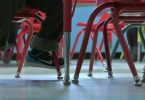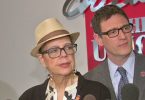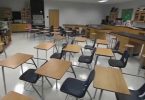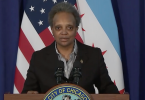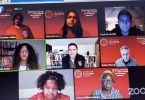by Todd Feurer, CBS Chicago web producer; CBS 2’s Chris Tye contributed to this report.
CHICAGO (CBS) — Facing a slow but steady rise in new COVID-19 cases in Chicago, and the possibility of a strike vote by the Chicago Teachers Union next week, Chicago Public Schools officials ditched plans to have some students in classrooms to start the school year, and announced a fully remote learning plan for the fall.
CPS Chief Executive Officer Janice Jackson and Mayor Lori Lightfoot announced Tuesday morning that all students would be learning remotely for at least the first quarter of the 2020-21 school year, which begins Sept. 8.
“In a perfect world, students would be in classrooms more not less, but unfortunately that is not where we find ourselves today,” Jackson said.
Three weeks ago, CPS announced plans for a hybrid approach to the start of the school year, with most students in classrooms twice a week, and learning from home three days a week. The district then sent out surveys to parents, and held virtual town hall meetings last week to discuss the plan.
Jackson said, based on feedback from parents, “it was evident that our families were not comfortable with the state of the pandemic, and the national response.”
According to CPS, only 28.1% of elementary school parents and 33.5% of high school parents said they planned to send their children to school if classrooms reopened in the fall; while 40.8% of elementary school parents, and 37.8% of high school parents said they wouldn’t. The rest were not sure.
The idea of returning to classrooms was especially unpopular among Black and Latinx families, compared to among White families. According to the CPS survey:
- 18.4% of the parents of Black elementary school students and 23% of the parents of Black high schoolers said they would send their children to school.
- 18% of the parents of Latinx elementary school students and 23.1% of the parents of Latinx high school students said they would send their kids to school.
- 44.7% of the parents of White elementary school students and 53.3% of the parents of White high school students said they planned to send their children to school.
However, Black and Latinx students make up the vast majority of the CPS student population. According to CPS statistics, 35.9% of students are Black, 46.6% are Latinx, and 10.8% are White.
“Although our families expressed how much they wanted to return to their school communities, and how much their students missed their friends and teachers, they did not feel that this is the right time” to have children back in classrooms, according to Jackson.
The remote learning plan will involve a mix of real-time instruction, small-group activities, and independent learning.
“Attendance will be mandatory,” Jackson said. “We are returning to normal grading; more infrastructure on a normal school setting.”
Parents have been told to expect a “final reopening framework in coming days.”
The city is in the process of installing free wi-fi around Chicago for families not connected. We are told the goal is 100,000 students with free wi-fi; it is unclear how many are signed on right now.
Everyone will be on the same digital platform, which CPS hopes will eliminate some hiccups experienced this spring.
Beyond the classroom, the city said:
• Additional meal sites will be online by the first day of school. Last year, CPS dished up 15 million meals.
• Safe Passage workers will remain in new capacities, including home visits.
• Childcare services are being developed for children of essential workers, though group care creates new concerns.
“There’s going to have to be some creativity inside the health and safety boundaries that are going to give these types of supports to families, because they’re going to need them,” said Jennie Biggs of of Raise Your Hand for Illinois Public Education..
And while the Illinois High School Association has said fall sports like golf, tennis, and track are a go even with no school, CPS initially indicated that those may be going away.
“It’s safe to say that if we can’t have in-person instruction, it’s highly unlikely we will have in sports in the fall,” Jackson said.
But hours later, a letter to principals, athletic directors and coaches from CPS Executive Director of Sports Administration David Rosengard appeared to communicate the opposite of what Jackson said.
“While we will continue to monitor the evolving public health situation in coordination with our public health partners, today’s announcement regarding remote learning did not impact our plans for summer conditioning or fall sports,” Rosengard wrote in the letter. “As we communicated last week, the district has adopted the IHSA’s modified fall sports schedule, which includes a reduced number of non-contact sports. Those sports may proceed as scheduled under the guidelines and precautions we previously released pending any potential public health developments that require a change in our approach.”
The Illinois State Board of Education has called for at least five hours a day of live instruction. The city said it has mechanisms in place to keep tabs on teacher accountability.
The announcement to shelve the hybrid plan for the start of the school year comes less than a day after sources confirmed the Chicago Teachers Union was planning to hold a possible strike vote over the reopening plan as early as next week to pressure CPS into starting the school year with remote learning only. The union had repeatedly criticized the hybrid plan in recent weeks, and had said the only safe option for back to school was a fully remote model.
In a statement Tuesday morning, CTU President Jesse Sharkey said the mayor and CPS need to commit to supporting every student and family through the pandemic.
“Our remote learning experience must include the infrastructure, professional development, family outreach and staff support to make remote learning robust and enriching for every student. We have a long way to go and a short time to get there. CPS must immediately start planning transparently and in partnership with our union to provide every student the educational, social and emotional supports they need to learn and grow,” Sharkey said. “We may not be teaching and supporting students in person this fall, but tens of thousands of teachers, clinicians, PSRPs, nurses, librarians and more stand ready to support our students through this pandemic. CPS’ remote learning plan must vastly improve on student and family experiences from the spring, and experts on the ground—our members—must be equal partners with the district in crafting those remote learning plans.”
Lightfoot denied that pressure from CTU tipped the scales on the decision for how to go back to school in the fall.
“As we have now repeatedly said about every decision that we’ve made in the context of this pandemic, we have to be guided by the science, period,” she said. “When we announced the potential for a hybrid model some weeks ago, we were in a very different place in the arc of the pandemic.”
Chicago Public Health Commissioner Dr. Allison Arwady said Chicago is now averaging 277 new COVID-19 cases per day, compared to as low as 170 four to five weeks ago, and the average seven-day positive test rate has risen from 3.8% a month ago to 4.8% as of Tuesday.
“The fact that over the last four to five weeks we’ve added between 80 and 100 cases, and not seen signs of that turning around, makes us concerned as we’re planning ahead for a complicated school district like CPS,” Arwady said.
Arwady said, if the city is able to get the case rate back below 200 new cases per day this fall, she would be comfortable moving forward with reopening schools. However, she said it’s entirely possible, at the rate things are going now, Chicago will be averaging more than 400 new cases per day by September, meaning remote classes would be the only safe option.
“If we are in a good place here from a local outbreak perspective, we would be able to move ahead with that hybrid option,” she said.
“We are all hoping to be in a position to move to that hybrid model beginning in quarter two. We will see what the data looks like, we will see what the feedback is from parents and teachers and staff, just as we’ve done here.”
Arwady also said the next few months will be an opportunity not only to learn from other school districts that are successfully reopening classrooms, as well as to teach children how to protect themselves from the virus.
The CPS decision on entirely remote classes to start the new school year gives district officials, teachers, and staff a month to develop a more comprehensive plan for virtual learning than was used during the spring.
“We have learned a lot of lessons from this past spring in order to improve remote learning. Students will be engaged for the entirety of a normal school day through a mixture of live real-time instruction with their classmates and teachers, small group activities, as well as independent learning,” Jackson said.
Lightfoot said she understands the remote learning plan will be a struggle for many parents who have to juggle work, childcare, and other needs at home.
“No one should have to choose between work and whether their child will have the resources that they need to thrive, and we will make sure that that is not a choice that has to happen,” she said. “In order to support families that don’t have the luxury of working from home, or have the resources to hire childcare, we have already started working with our community partners to develop plans to ensure that all students are safely cared for. Parents and families deserve peace of mind, and it is our responsibility to do everything that we can to deliver that.”
Lightfoot and Jackson declined to say if some school buildings would be open during the fall for students whose parents must work, and can’t afford childcare, much like the district did when teachers were on strike last fall.
“We’re looking at a range of options. We know that, for some parents, they simply can’t afford to stay home. They don’t have that luxury, and we want to make sure that, particularly for those parents, our essential workers, that their students have every opportunity to learn as possible,” Lightfoot said.
Jackson emphasized that CPS also would continue its meal distribution program as long as it’s needed, and will continue providing mobile devices to families who need them, and help sign up families for the aforementioned free high-speed broadband access.
A decision on whether students will return to class in the second quarter will be made later this year, after officials evaluate the COVID-19 situation this fall. The first quarter ends Nov. 8.
“Very light getting some kids into school, if it’s safe to do it, in a manner that might make sense,” Biggs said.
Jackson and Lightfoot said, if CPS is to reopen classrooms after the first quarter, people in Chicago need to continue wearing masks in public, while keeping their distance from others, and following other public health guidance to slow the spread of the virus.
“We owe it to our entire city, our entire community, and particularly our youngest and most vulnerable residents to do what is necessary to make sure that Chicago remains on the right path when it comes to COVID-19,” Lightfoot said.

